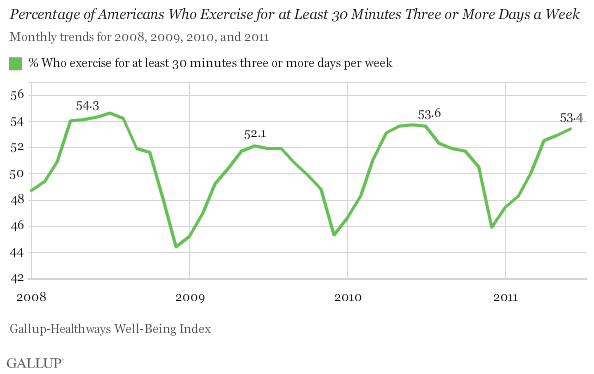WASHINGTON, D.C. -- Americans' levels of exercise have tapered off slightly in 2011, after partially rebounding in 2010, and are still not as high as in 2008. The 53.4% of adults who reported exercising for at least 30 minutes three or more days per week in June trails the 54.3% in the same month in 2008.

Frequent exercise levels have yet to fully recover to levels recorded in 2008. Americans' frequent exercise levels fell in the fall of 2008 as the nation's financial crisis took hold and remained suppressed in 2009.
The drop this year in exercise frequency also mirrors a downturn in fruit and vegetable consumption and in healthy eating in general.
Gallup asks 1,000 American adults daily about their exercise habits as part of the Gallup-Healthways Well-Being Index. Americans typically exercise more in the spring and summer and less in the fall and winter.
Seniors Lead Decline in Frequent Exercise
Less than half (48.4%) of seniors, those aged 65 and older, reported exercising for at least 30 minutes three or more days per week in the first half of 2011 -- making them not only among the least likely to say they exercise frequently across all demographic groups, but also the group with the largest decrease in exercise levels since 2008.
Americans aged 45 to 64, Hispanics, and those living in the East are also among the most likely to report exercising less this year than in 2008.
Young adults, on the other hand, are the most likely to exercise frequently, and their levels of exercise are the most improved from 2008. Black Americans are also exercising more frequently than in 2008, but are still among the least likely to do so.

The small but significant decline in frequent exercise since the economic crisis may reveal a connection between financial strain and health habits. With millions of Americans struggling to get work, pay their mortgage, and feed their families, exercise may not be a top priority.
About the Gallup-Healthways Well-Being Index
The Gallup-Healthways Well-Being Index tracks U.S. and U.K. well-being and provides best-in-class solutions for a healthier world. To learn more, please visit well-beingindex.com.
Survey Methods
Results are based on telephone interviews conducted as part of the Gallup-Healthways Well-Being Index survey Jan. 2-June 30, 2011, with a random sample of 176,504 adults, aged 18 and older, living in all 50 U.S. states and the District of Columbia, selected using random-digit-dial sampling.
For results based on the total sample of national adults, one can say with 95% confidence that the maximum margin of sampling error is ±1 percentage point.
Interviews are conducted with respondents on landline telephones and cellular phones, with interviews conducted in Spanish for respondents who are primarily Spanish-speaking. Each sample includes a minimum quota of 400 cell phone respondents and 600 landline respondents per 1,000 national adults, with additional minimum quotas among landline respondents for gender within region. Landline telephone numbers are chosen at random among listed telephone numbers. Cell phone numbers are selected using random-digit-dial methods. Landline respondents are chosen at random within each household on the basis of which member had the most recent birthday.
Samples are weighted by gender, age, race, Hispanic ethnicity, education, region, adults in the household, and phone status (cell phone only/landline only/both, cell phone mostly, and having an unlisted landline number). Demographic weighting targets are based on the March 2010 Current Population Survey figures for the aged 18 and older non-institutionalized population living in U.S. telephone households. All reported margins of sampling error include the computed design effects for weighting and sample design.
In addition to sampling error, question wording and practical difficulties in conducting surveys can introduce error or bias into the findings of public opinion polls.
For more details on Gallup's polling methodology, visit www.gallup.com.
